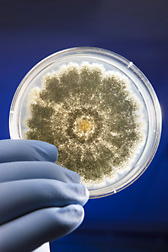Habitat
 Aspergillus flavus has the capacity to grow on many nutrient
sources. It is mainly a saprophyte and grows on dead plant and
animal tissue in the soil, which is important for the recycling
of nutrients. Because it grows well on decaying
vegetation, one common place you might find Aspergillus is in compost or on fallen leaves. However, this fungus is also a parasite and
can use living organisms as hosts. Host species include
corn, peanuts, nut trees, cotton, and even humans. To find out more about
how A. flavus engages in parasitism visit the
interactions page!
Aspergillus flavus has the capacity to grow on many nutrient
sources. It is mainly a saprophyte and grows on dead plant and
animal tissue in the soil, which is important for the recycling
of nutrients. Because it grows well on decaying
vegetation, one common place you might find Aspergillus is in compost or on fallen leaves. However, this fungus is also a parasite and
can use living organisms as hosts. Host species include
corn, peanuts, nut trees, cotton, and even humans. To find out more about
how A. flavus engages in parasitism visit the
interactions page!
 Typically this organism favors hot, dry
conditions which makes it unique in comparison to other fungi.
The best temperature for growth is 37°C (98.6°F). However, it
can grow at any temperature between 12-48°C (54-118°F).
Aspergillus flavus is omnipresent in nature but has a
more limited
growth indoors. Aspergillus molds thrive best in
oxygen-rich environments and also on materials that are rich in
carbon which they feed off of for nutrients.
Typically this organism favors hot, dry
conditions which makes it unique in comparison to other fungi.
The best temperature for growth is 37°C (98.6°F). However, it
can grow at any temperature between 12-48°C (54-118°F).
Aspergillus flavus is omnipresent in nature but has a
more limited
growth indoors. Aspergillus molds thrive best in
oxygen-rich environments and also on materials that are rich in
carbon which they feed off of for nutrients.
Aspergillus can often be found growing inside dirty air
conditioners inside of buildings or in your own home. This has
even been known to be a problem in some hospitals. Aspergillus
may also grow on or inside walls in homes, especially if the
house is damp or has been
damaged by flooding.
Check out some of the adaptations of A. flavus!



